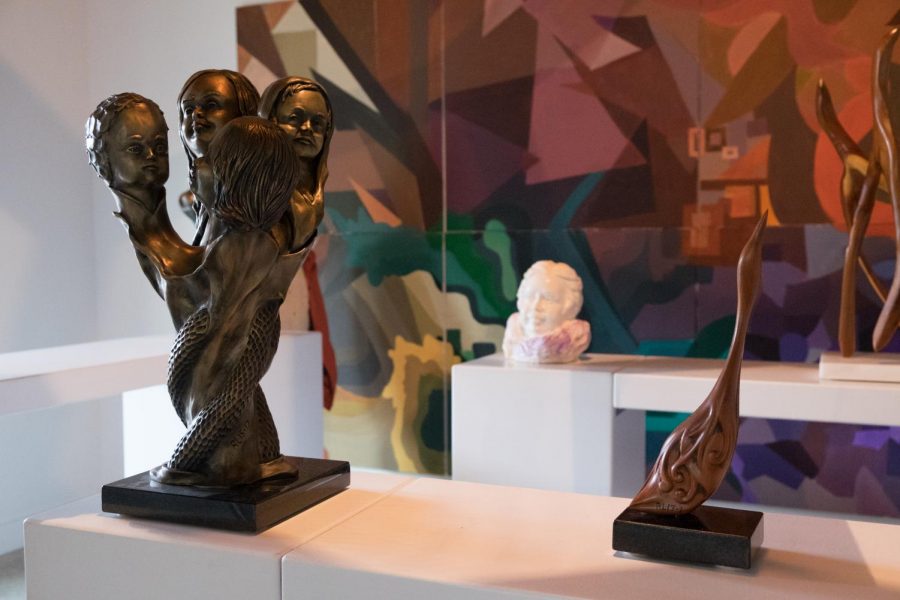Exhibit presents the intersection of art, science
The Institute for Genomic Biology’s Art of Science exhibit is located in the southwest sunroom of the Broadway Food Hall.
April 13, 2018
Creativity can sprout from whatever fresh and exciting wonder the mind happens to stumble upon, whether it be a cherry-colored leaf clinging to a scraggly branch, a thin blade of grass drifting in the breeze or a fluffy cloud tumbling through the sky.
However, inspiration is often constrained to what can be seen, heard or felt on the surface. Rarely does the human eye have the ability to perceive organisms thinner than the width of a hair, rendering an entire realm of possibility nearly invisible.
Dr. Courtney Fenlon, outreach activities manager of the Institute for Genomic Biology, considers this oversight as a lost opportunity. She believes that the general public is missing out on a lot. Thousands of microscopic masses and organisms, to be exact.
“We plan to draw the community in with a visual representation of science,” Fenlon said. “We utilize images because art is often very accessible to the public, and everyone can come and see.”
Fenlon continually helps to expose these tiny, yet complex, images to the community through the institute’s yearly Art of Science Exhibit, which is preparing to enter its eighth season on display in C-U.
Get The Daily Illini in your inbox!
The Art of Science 8.0, which will be hosted at Broadway Food Hall, 401 N. Broadway Ave., in Urbana beginning Thursday and running through May 13, aims to investigate the intricate relationship between art and science, and how each sheds light on the other in an increasingly multidisciplinary field of research.
For each program, the IGB submits an original catalog of spectroscopic data, used for the institute’s visual study of DNA found in plants, crops and cancer cells. These images, accompanied by brief informational captions in the exhibit, form a collage of scientific inquiry and artistic exploration, resisting one singular definition to be assigned by viewers.
While the majority of the exhibit’s selections are drawn from the institute’s main spectroscopy facility, Fenlon, who has been involved in planning the event for three years, stresses the diverse portfolio of research to be sampled at the art show, which is free and open to the public.
“I think what makes our art unique is that we really try to bring in images from all the different types of research that we’re doing at the institute,” Fenlon said. “My favorite part of the event is getting to see everyone’s reactions to the art, but also opening those reactions and being able to discuss science with the people visiting to the exhibit.”
Noah Dibert, creative program manager of the IGB and curator of this year’s show, has already encountered a flurry of activity in his first year curating the event’s artwork.
“We’re trying to paint with pretty broad strokes,” Dibert said. “The whole thing is pretty new and pretty exciting for me; to see how it’s going to be received by the broader audience outside of the Institute of Genomic Biology.”
To date, the Art of Science program has never displayed the same piece of artwork twice. This year’s program will fall under a similarly adventurous theme, highlighting photography of kidney stones, rocks, E. Coli and brain neuron mapping.
While the Art of Science may be an accessible and fruitful introduction to the world of research for scientific newcomers, Fenlon thinks that even biology students who are familiar with their major can expect surprises from the event.
“The exhibit gives (undergraduates) an opportunity to see how their interests are being applied in day-to-day research,” Fenlon said. “It’s also a really great opportunity to meet some of the researchers at our institute; to kind of find where their interests lie. I think undergraduate studies are a time to really discover yourself and what you’re passionate about.”
Thomas Chow, freshman in LAS, has dug deep into his studies in molecular and cellular biology. Through experience, he’s learned to use pictures as a scientific aid. While school work can get challenging for him from time to time, drawing out visuals and diagrams usually guides him through his confusion with book problems and lecture notes.
For Chow, the Art of Science offers an intriguing chance to find parallels between professional and student life.
“I feel like some pictures or art-related thing might appear that is related to what I’ve learned so far,” Chow said. “I would definitely look at something that we’ve covered or something I know of, and I’d probably spend more time looking at the description and how art is made.”
Combining the concepts of art and science together into the same sentence may not be as much of a stretch as is commonly thought. After all, both art and science are the simple expression of abstract ideas, each with an enormous degree of freedom and potential to their name.
Letting the mind roam around the Art of Science for only a moment, Dibert said, will give viewers a taste of this untamed creativity.
“You want it to be really left up to the visitor what they take away from the art exhibit,” Dibert said. “If they get an idea of the different forms of genomic sciences and what we’re doing here, that’s great. If they just like the visually pleasing art pieces, that’s even better.”







